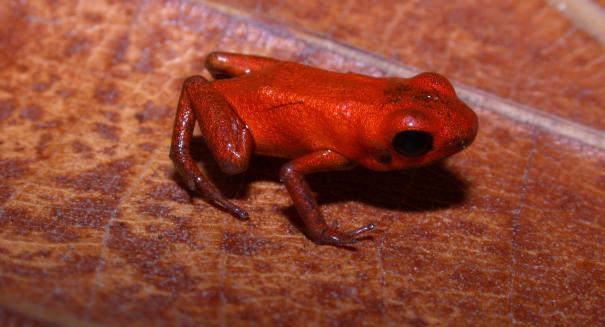
Researchers discovered a new species of poison dart frog in the Colon Province of Panama, distinctive in its uniformly orange skin, smaller physical frame, and unique male call.
A study published last Wednesday in the journal Zootaxa reveals the discovery of a new poison dart frog species in west central Panama.
Researchers of the study, led by Abel Batista of the Universidad Autónoma de Chiriquí in the Republic of Panama, confirmed that it was a new species during field work in the Donoso District of Colon Province in Panama. According to a recent statement, the species was named Andinobates geminisae for Geminis Vargas, “the beloved wife of [coauthor] Marcos Ponce, for her unconditional support of his studies of Panamanian herpetology.”
The study reveals that the Andinobates geminisae species differs from all other members of the group with its uniformly orange skin and a distinctive male call. Researchers also state that the species is smaller than other poison dart frogs in the area, such as the Oophaga pumilio.
“Abel Batista and Marcos Ponce were the first to note the presence of this species,” said co-author Cesar Jaramillo of the Smithsonian Tropical Research Institute. “They’ve known it was there for several years. However, they were not sure if it was only a variety of another poison dart frog species, Oophaga pumilio, which exhibits tremendous color variation. Based on morphological characteristics of the adult and the tadpole, I thought it might be a new species of Andinobates.”
According to the statement, co-author Andrew Crawford of the Universidad de Los Andes took the lead in sequencing the DNA of the frog. Phylogenetic results from the study confirmed that it was indeed a member of the Andinobates minutus species group, and additional genetic distances suggest that Andinobates geminisae could be considered a candidate species.
Researchers are concerned about the population stability of the geographically restricted new species due to a number of factors. According to the statement: “A. geminisae is included in the captive breeding program of the Panama Amphibian Rescue and Conservation project, a consortium of six zoos and research institutions dedicated to saving amphibians from the chytrid fungal disease, which is decimating amphibians worldwide, and habitat loss.”
Leave a Reply